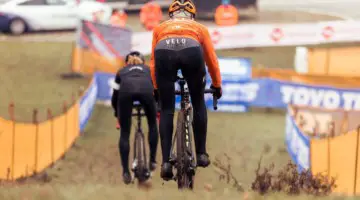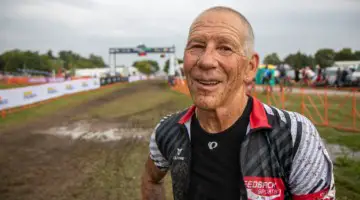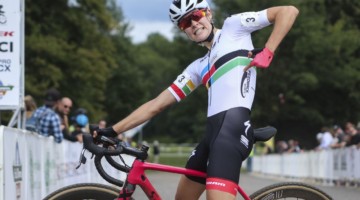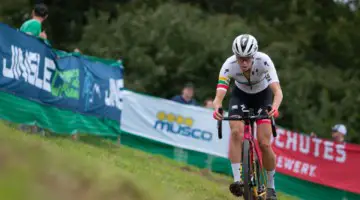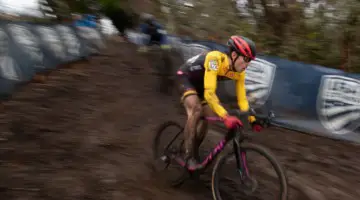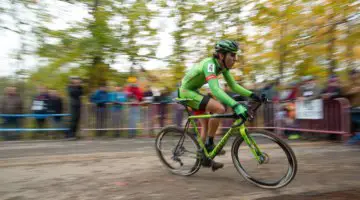You can’t win a cyclocross race at the start, and yet riders consistently “overstart.” They go out too hard and then slowly lose places the rest of the race. That’s a topic I’d like to spend this article unpacking and explaining.
It’s a very common mistake, I think one of the most common in cyclocross even for experienced riders. Why do people do it? Why do they keep doing it? Why doesn’t it work? What should you be doing instead?
What is Overstarting?
What am I talking about specifically when I say overstarting? I mean going VERY HARD from the gun for as long as you can hold it. This means winning the holeshot or leading the race for the first half to full lap and then spending the rest of the race losing spots.
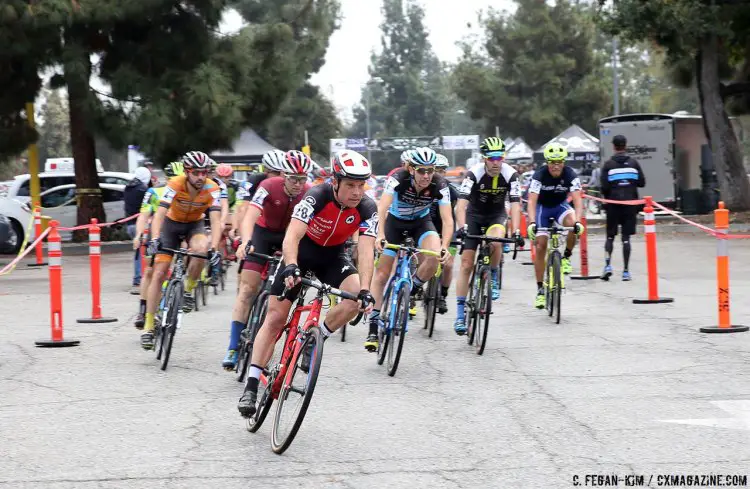
Winning the holeshot can get you into a race report, but going out too fast can derail your day of racing. 2016 CXLA Day 2. © Cathy Fegan-Kim / Cyclocross Magazine
We’ve all seen it happen. At some point we’ve probably done it. Even if you’re not leading the race I would still consider it an overstart if you’re losing more than five spots after the first lap every race.
Another way to gauge your effort is how much you have to recover in the middle of the race. Do you have to soft-pedal the second and third laps? You’ve overstarted. Do you spend the first lap in a group of riders that then finishes over a minute ahead of you? You may have overstarted.
Why do people do it? People drawn to ’cross often have a relatively high percentage (aerobic athletes) of fast twitch muscle fibers. That allows them (us, me!) to go a lot harder in a variable manner for 30-60 minutes than they could in a steady state effort.
In road racing or even criteriums the sprint comes at the end of the race such that the power generated is the maximum power one can generate in a fatigued manner. In ’cross the field sprint starts the race when riders are rested and ready and can put forth a maximal fresh effort. This type of arrangement is common in BMX, certain types of mountain bike racing and some track events. For a lot of people it’s a way to make maximal use of a physiological strength.
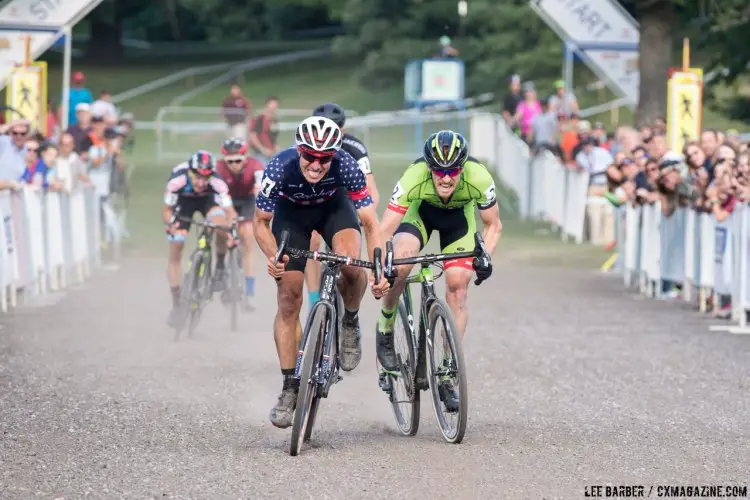
Sprints at the end of cyclocross races are rare. The important one is usually at the start. Rochester Cyclocross 2016, Day 2, Elite Men. © Lee Barber
At a psychological level it’s pure fight or flight, emphasis on flight. We’re primed and ready to DO SOMETHING and going as hard as possible is a very natural reaction for our monkey brains to have. And, of course, we’ve all seen or been caught up in early crashes or been caught behind competitors we’d rather not be behind. So going hard early makes all kind of sense, in the moment.
What tends to happen is that people have a hammer—excellent power for about 60 seconds—and see nails all around them. They start hard each and every time thinking it will work out and that this time they’ll be able to hold on a little longer this time and achieve their desired result.
The fast start makes its Siren call to athletes who have this tool at their disposal, and pros and amateurs alike are unable to resist.
Feeling Like Superman, For a Minute or Two
So why doesn’t it work? The power generating mechanism involved—anaerobic power—is unsustainable and finite. Think of it as a tank of nitrous oxide.
In a rested state you have a finite amount of energy and you can spend it however you like. If you want to drain that tank to the biggest effect, you do it very quickly in less than one minute. Even for up to five minutes you can use the tank to go harder than you could in an aerobic state. But after you exhaust that tank you have to drop below threshold to pay it back.
You get to be Superman for a few minutes, but then you get exposed to Kryptonite after that effort. So there ends up not being a lot of middle ground between flying and limping, hence the soft-pedaling on lap two and even three.
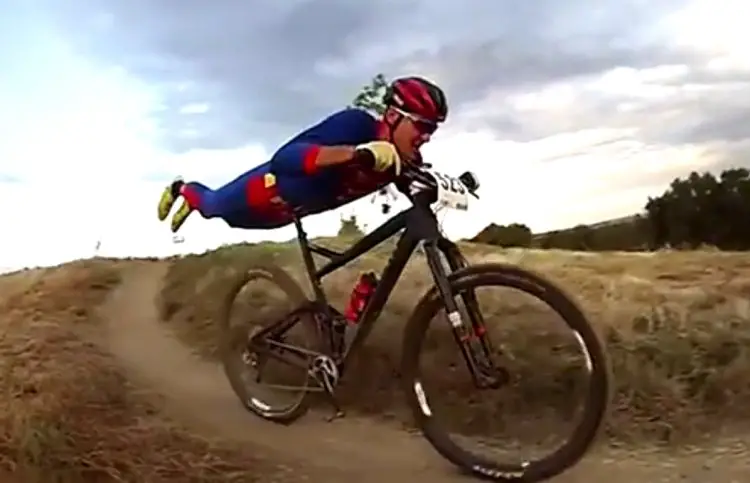
We are not Superman, even if we feel like it for a minute or two during a race. Brady Kappius as Superman at Valmont Park.
You’ll never be able to go hard enough on lap one that you’ll gap everyone so by so much that you can soft-pedal for a lap and then still have a race-winning gap. Put another way, if you wanted to be the first one to the top of a long climb, would you attack the bottom of it like a ’cross start and then expect to win?
Every great once in a while you see someone win from the gun. But that person was going to win the race anyway. They could have just as easily sat in the whole race and lit up the last lap as hard as they did the start. Those wins are not evidence that starting hard is a good strategy, they are evidence that person was at a different level than everyone else in the race.
How to Avoid Overstarting
So what should you be doing? Start hard enough to stay out of trouble and to stay with your peer group. If you’re staged via Crossresults.com rankings (or the new Coke version) just stay with the row you’re in. I take 15 very conscious hard pedal strokes to get up to speed and then look around to see where I am. If I’m about where I should be, I turn off the effort and just pedal as hard as I need to maintain my position during the first lap.
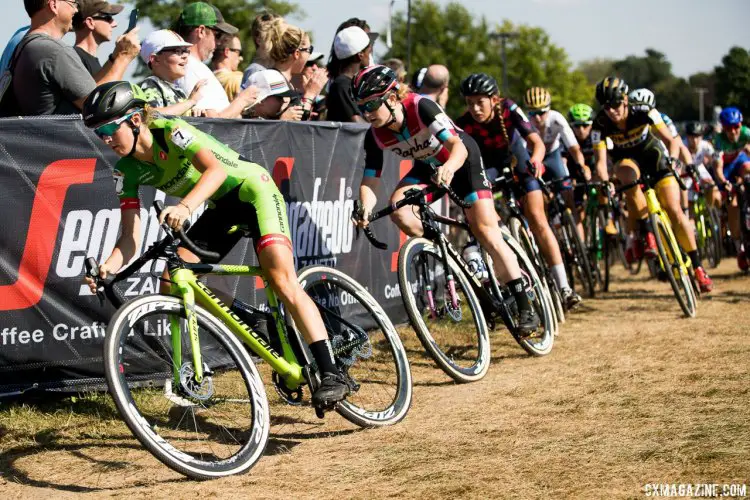
FIgure out where you want to be coming out of the holeshot. 2017 World Cup Waterloo © J. Curtes / Cyclocross Magazine
My mantra (out loud) is “do not burn matches.” The race will settle out on its own accord without me having to expend energy to make that happen by the end of the first lap. If I am not where I want to be after those first few pedal strokes I think of the spots that have long straightaways for clean passes and allow myself one match to burn to move up to where I’d like to be. (Speaking of hammers and nails, you can see my solution to problems is to apply more watts to the situation rather than rip through corners. Use your own skill set appropriately).
Use that big tank at the end of the race to light up your competition against people you are similarly matched with. Don’t use it to end up in a pedaling contest against people that can pedal better in the last lap of a race than you can. It’s a hard thing to do. It takes confidence in your abilities. It takes patience in the heat of the moment to allow things to unfold without you actively doing something. But those are marks of maturation in racing.
Jeremy Powers didn’t win a national championship until he switched up his racing style. Stephen Hyde has always been pretty good about being patient in a race and making moves much later in the race. His win at Rochester is a very good example of that.
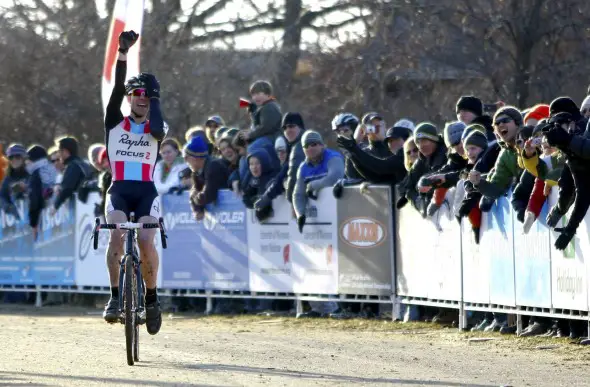
Jeremy Powers finally got his first Nationals win in 2012 when he changed up his race strategy. ©Tim Westmore
You’ve got a particular skill set. I want you to use it. But I want you to understand how best to employ those skills to benefit your racing. Doubling down on a particular strategy is a Siren’s call for many racers. But have some faith in your ability to utilize a more effective strategy that will result in a better outcome. And good luck in your next race!
Have some faith you can resist the call of overstarting and utilize a more effective strategy that will result in a better outcome. And good luck in your next race!























